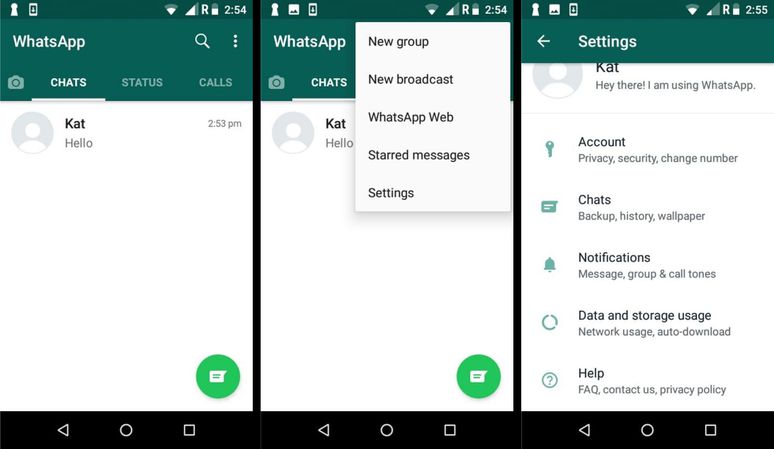WhatsApp Last Seen Privacy Explained & Tips sets the stage for this enthralling narrative, offering readers a glimpse into a story that is rich in detail and brimming with originality from the outset. Dive into this comprehensive guide to unravel the intricacies of WhatsApp’s “Last Seen” feature, exploring its privacy implications, customization options, and ethical considerations.
Our journey begins with a thorough examination of the “Last Seen” feature, shedding light on its purpose and the potential risks and benefits associated with sharing this information. We will then delve into the practicalities of disabling “Last Seen” and explore the consequences of doing so.
Along the way, we will uncover the nuances of customizing “Last Seen” privacy settings for specific contacts and delve into the exceptions where “Last Seen” may still be visible even when disabled.
WhatsApp Last Seen Privacy Overview
WhatsApp’s “Last Seen” feature allows users to display the time they were last active on the app. While it provides convenience, it also raises privacy concerns. Understanding the implications of sharing “Last Seen” information is crucial for maintaining privacy.
Potential Risks
- Stalker behavior:Individuals with malicious intent can track your online activity, potentially leading to harassment or stalking.
- Unwanted contact:People you may not want to communicate with can determine when you are available, increasing the likelihood of unwanted contact.
- Compromised privacy:Your “Last Seen” information can reveal your sleep patterns, work hours, and other personal details.
Potential Benefits
- Convenience:Allows contacts to see if you are online and available for immediate communication.
- Accountability:Employers or family members can monitor your online activity, ensuring accountability and safety.
- Business purposes:Businesses can use “Last Seen” to track employee availability during work hours.
Disabling “Last Seen” Privacy
The “Last Seen” feature in WhatsApp displays the time when you were last active on the app. Disabling this feature can enhance your privacy, but it also has certain consequences.
Steps to Disable “Last Seen”
- Open WhatsApp.
- Tap on the three dots in the top-right corner.
- Select “Settings”.
- Tap on “Account”.
- Select “Privacy”.
- Toggle the “Last Seen” option to “Nobody”.
Consequences of Disabling “Last Seen”
When you disable “Last Seen”, the following occurs:
- Your contacts will not be able to see when you were last active on WhatsApp.
- You will not be able to see when your contacts were last active on WhatsApp.
Tips for Managing Privacy Settings
To manage your privacy settings effectively when “Last Seen” is disabled, consider the following tips:
- Use WhatsApp’s “Status” feature to communicate your availability without revealing your last active time.
- Set your profile picture to a non-personal image or avatar.
- Limit the information you share in your profile, such as your phone number or location.
Customizing “Last Seen” Privacy
Customizing “Last Seen” privacy allows you to control who can see your last active time on WhatsApp. This feature offers flexibility in managing your online presence and privacy with specific contacts.
To customize “Last Seen” privacy:
- Open WhatsApp and tap on the “Settings” icon.
- Select “Account” and then “Privacy.”
- Tap on “Last Seen” and choose one of the following options:
- Everyone:All WhatsApp users can see your last active time.
- My Contacts:Only contacts saved in your phone’s address book can see your last active time.
- Nobody:No one can see your last active time.
- My Contacts Except…:You can exclude specific contacts from seeing your last active time.
Benefits of Customizing “Last Seen” Privacy
- Enhanced privacy:You can prevent specific contacts or strangers from knowing when you were last online.
- Reduced interruptions:If you don’t want to be disturbed by certain people, you can hide your last active time from them.
- Flexibility:You have the option to choose different privacy settings for different contacts, allowing you to tailor your online presence.
Limitations of Customizing “Last Seen” Privacy
- Limited visibility:If you hide your last active time from someone, they won’t be able to see yours either.
- Potential confusion:If you frequently change your “Last Seen” privacy settings, it may confuse other users.
- No complete anonymity:Even if you hide your last active time, other indicators such as typing or recording status may still reveal your online presence.
Scenarios Where Customizing “Last Seen” Privacy Can Be Useful
- Managing professional and personal contacts:You may want to hide your last active time from professional contacts during off-hours.
- Avoiding unwanted attention:If you receive excessive messages or calls from certain individuals, you can block them from seeing your last active time.
- Protecting privacy in sensitive situations:In certain situations, such as legal disputes or personal emergencies, you may want to limit who can see your online presence.
Understanding “Last Seen” Exceptions
While disabling “Last Seen” offers increased privacy, it’s crucial to understand that there are certain situations where your “Last Seen” status may still be visible to others. This section will delve into these exceptions, exploring their underlying reasons and providing practical tips to minimize their impact on your privacy.
Group Chats
Even with “Last Seen” disabled, your “Last Seen” timestamp may be visible to participants in group chats where you’re actively engaged. This is because group chats require real-time communication, and displaying members’ “Last Seen” status helps maintain a sense of presence and engagement within the group.
Status Updates
If you post a status update, your “Last Seen” status will become visible to all your contacts for the duration of the status’s visibility. This is because status updates are designed to share real-time updates and foster interactions among contacts.
Avoiding Unintentional “Last Seen” Disclosure
- Delay Status Updates:Consider delaying status updates until after you’ve closed WhatsApp to avoid unintentionally revealing your “Last Seen” status.
- Limit Group Chat Participation:If privacy is a major concern, consider limiting your participation in group chats where your “Last Seen” status may be visible.
- Use a Third-Party App:There are third-party apps available that allow you to disable “Last Seen” even in group chats and while posting status updates. However, it’s important to thoroughly research and verify the privacy policies of such apps before using them.
Third-Party Apps and “Last Seen” Privacy
While WhatsApp provides built-in privacy options for “Last Seen,” some users may seek additional control or functionality by utilizing third-party apps. However, it’s crucial to be aware of potential privacy risks associated with such apps.
Third-party apps that claim to track or modify “Last Seen” status may require access to your WhatsApp account or personal information. This can create opportunities for malicious actors to exploit vulnerabilities or collect sensitive data without your knowledge or consent.
Identifying and Avoiding Malicious or Unreliable Apps
- Read app reviews and ratings from reputable sources.
- Check the app’s privacy policy to understand how your data will be used.
- Be wary of apps that request excessive permissions or seem overly intrusive.
- Avoid downloading apps from untrustworthy sources or unknown developers.
- Consider using only official WhatsApp-approved apps or plugins.
Best Practices for Protecting Privacy When Using Third-Party Apps
- Grant only necessary permissions to the app.
- Monitor your WhatsApp privacy settings regularly to ensure they haven’t been modified.
- Use a strong and unique password for your WhatsApp account.
- Be cautious about sharing personal information or sensitive data with third-party apps.
- Uninstall any third-party apps that you no longer use or that you suspect are compromising your privacy.
Ethical Considerations of “Last Seen” Privacy

The monitoring or tracking of “Last Seen” information raises significant ethical concerns. It has the potential to facilitate stalking or harassment, as individuals can use this data to track someone’s online presence and infer their activities.
Responsible use of “Last Seen” privacy features is crucial. Individuals should be mindful of the potential implications of sharing their “Last Seen” information and use it judiciously. They should also respect the privacy of others and refrain from using “Last Seen” data to track or harass them.
Potential for Stalking or Harassment
Tracking someone’s “Last Seen” information can provide insights into their online behavior, including the times they are most active, their sleep patterns, and their social interactions. This information can be used by stalkers or harassers to target their victims, monitor their movements, and potentially escalate their behavior.
Guidelines for Responsible Use
To promote responsible use of “Last Seen” privacy features, individuals should consider the following guidelines:
- Be mindful of who you share your “Last Seen” information with.
- Use privacy settings to limit who can see your “Last Seen” status.
- Disable “Last Seen” if you have concerns about privacy or safety.
- Respect the privacy of others and do not use “Last Seen” data to track or harass them.
- If you are being stalked or harassed, report it to the appropriate authorities and seek professional help.
Comparative Analysis of “Last Seen” Privacy Across Messaging Platforms

The “Last Seen” feature on messaging platforms provides users with control over their online presence and privacy. However, different platforms approach this feature in varying ways, offering unique advantages and disadvantages.
Let’s compare the “Last Seen” privacy features of WhatsApp with other popular messaging platforms, including Telegram, Signal, and Facebook Messenger:
- Users can choose to display their “Last Seen” to everyone, their contacts only, or no one.
- The “Last Seen” timestamp updates when a user opens the app or sends a message.
- Users can disable the “Last Seen” feature altogether, making it impossible for others to see when they were last online.
Telegram
- Users have three “Last Seen” options: “Everybody,” “My Contacts,” and “Nobody.”
- Telegram also offers a “Last Seen Recently” feature that displays a general timeframe (e.g., “last seen within a day”) instead of a specific timestamp.
- Users can customize their “Last Seen” settings for specific contacts.
Signal
- Signal does not have a traditional “Last Seen” feature.
- Instead, it displays a “Last Active” timestamp that indicates when a user was last online, but only to contacts who have recently messaged them.
li>Users can choose to disable the “Last Active” feature altogether.
Facebook Messenger
- Users can choose to display their “Active Status” to everyone, their friends only, or no one.
- The “Active Status” timestamp updates when a user is actively using the app or has recently sent a message.
- Users can also choose to turn off the “Active Status” feature for specific contacts.
Advantages and Disadvantages
Each platform’s approach to “Last Seen” privacy has its own advantages and disadvantages:
- WhatsApp:Offers granular control over “Last Seen” visibility, including the option to disable it entirely.
- Telegram:Provides a more flexible “Last Seen” system with options for customizing settings for specific contacts and displaying a general timeframe instead of a precise timestamp.
- Signal:Offers the highest level of privacy by eliminating the traditional “Last Seen” feature and only displaying “Last Active” information to contacts who have recently messaged the user.
- Facebook Messenger:Similar to WhatsApp, it offers granular control over “Active Status” visibility but may be less private due to its integration with other Facebook services.
Best Practices
When managing “Last Seen” privacy across different platforms, consider the following best practices:
- Choose the “Last Seen” settings that best suit your privacy preferences and level of comfort.
- Be aware of the differences in “Last Seen” privacy features across different platforms and adjust your settings accordingly.
- Consider disabling the “Last Seen” feature altogether if you value maximum privacy.
- Customize your “Last Seen” settings for specific contacts if you want to control who can see your online status.
Ultimately, the best approach to “Last Seen” privacy depends on your individual preferences and the level of privacy you seek.
Advanced “Last Seen” Privacy Techniques
Enhance your “Last Seen” privacy by employing advanced techniques, such as leveraging privacy-focused messaging apps or virtual private networks (VPNs).
Privacy-Focused Messaging Apps
Utilize messaging apps that prioritize privacy, offering features like end-to-end encryption and ephemeral messages. These apps minimize data collection and enhance your online anonymity.
Virtual Private Networks (VPNs), WhatsApp Last Seen Privacy Explained & Tips
Mask your IP address with a VPN, making it more challenging for others to track your online activity. This also prevents apps from determining your location, which can influence “Last Seen” visibility.
Implementation Recommendations
- Choose a privacy-focused messaging app that aligns with your communication needs.
- Enable end-to-end encryption and ephemeral messaging features within the app.
- Subscribe to a reputable VPN service and connect to a server in a different location to mask your IP address.
- Be mindful of the trade-offs between privacy and convenience. Advanced techniques may limit certain app functionalities.
Emerging Trends in “Last Seen” Privacy: WhatsApp Last Seen Privacy Explained & Tips
The landscape of “Last Seen” privacy is constantly evolving, driven by technological advancements and changing societal norms. Emerging trends and innovations are shaping the way we manage and protect our “Last Seen” information, with potential implications for the future of online privacy.
AI-Powered Privacy Enhancements
Artificial intelligence (AI) is revolutionizing “Last Seen” privacy by enabling automated and personalized privacy controls. AI algorithms can analyze user behavior patterns, preferences, and contextual factors to tailor “Last Seen” settings that align with individual needs. This allows users to enjoy enhanced privacy without the need for manual configuration.
Decentralized Messaging Platforms
Decentralized messaging platforms, which operate without a central authority, are gaining popularity as they offer greater control over user data. These platforms often implement end-to-end encryption and allow users to manage their “Last Seen” status independently, reducing the risk of data breaches and unauthorized access.
Biometric Authentication
Biometric authentication, such as fingerprint or facial recognition, is emerging as a secure and convenient way to control “Last Seen” privacy. By linking “Last Seen” settings to biometric data, users can ensure that only authorized individuals can access their “Last Seen” information, even if their device is compromised.
Privacy-Focused Messaging Apps
A growing number of messaging apps are prioritizing user privacy by offering advanced “Last Seen” privacy features. These apps may allow users to selectively share their “Last Seen” status with specific contacts, hide their “Last Seen” from certain individuals, or even disable “Last Seen” altogether.
Best Practices for Managing “Last Seen” Privacy
Managing “Last Seen” privacy requires a proactive approach. Here are some key best practices to safeguard your information:
Comprehensive Checklist for “Last Seen” Privacy
- Disable “Last Seen” for enhanced privacy.
- Customize “Last Seen” settings to limit visibility to specific contacts.
- Understand “Last Seen” exceptions and how they impact your privacy.
- Be cautious of third-party apps that may compromise “Last Seen” privacy.
- Consider the ethical implications of “Last Seen” privacy.
- Stay informed about “Last Seen” privacy updates and emerging trends.
- Employ advanced “Last Seen” privacy techniques for added protection.
Additional Tips and Resources
* Utilize privacy-focused messaging platforms that offer robust “Last Seen” privacy controls.
- Implement strong passwords and two-factor authentication to protect your WhatsApp account.
- Regularly review and adjust your privacy settings to ensure optimal protection.
- Seek guidance from reputable online privacy resources for additional tips and support.
Ultimate Conclusion

As we conclude our exploration of WhatsApp Last Seen Privacy, we will delve into the ethical considerations surrounding the monitoring or tracking of “Last Seen” information. We will also provide a comparative analysis of “Last Seen” privacy features across popular messaging platforms, identifying best practices for managing “Last Seen” privacy across different platforms.
To empower you with the knowledge to protect your online privacy, we will share advanced “Last Seen” privacy techniques and discuss emerging trends and innovations in this domain. Our aim is to equip you with the tools and insights necessary to make informed decisions about managing your “Last Seen” privacy and safeguarding your online presence.
FAQ Corner
What is the purpose of WhatsApp’s “Last Seen” feature?
WhatsApp’s “Last Seen” feature indicates the last time a user was active on the platform. It allows users to see when their contacts were last online, and vice versa.
What are the privacy implications of sharing “Last Seen” information?
Sharing “Last Seen” information can reveal your online activity patterns and potentially compromise your privacy. It can make you vulnerable to stalking or harassment, as individuals can track your online presence and infer your whereabouts.
How can I disable “Last Seen” in WhatsApp?
To disable “Last Seen” in WhatsApp, navigate to Settings > Account > Privacy > Last Seen and select “Nobody.”
What are the consequences of disabling “Last Seen”?
Disabling “Last Seen” prevents others from seeing when you were last active on WhatsApp. However, you will also be unable to see when your contacts were last online.
How can I customize “Last Seen” privacy settings for specific contacts?
To customize “Last Seen” privacy settings for specific contacts, navigate to Settings > Account > Privacy > Last Seen and select “My Contacts Except…” or “Only Share with…”




